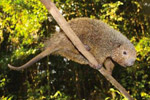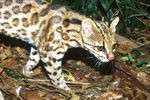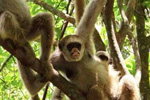Brazil can protect and restore Mata Atlântica for 6.5 percent of what it spends on agricultural subsidies
Want to save the world’s most imperiled biodiversity hotspot? You just need a down payment of $198 million. While that may sound like a lot, it’s actually less than it cost to make the film, Titanic. A new study published today in Science finds that paying private landowners to protect the almost-vanished Atlantic Forest would cost Brazil just 6.5 percent of what it currently spends ever year on agricultural subsidies.
When Europeans first arrived in Brazil they found a vast forest stretching along the entire eastern coast, full of species found nowhere else: this was the Atlantic Forest or Mata Atlântica. Today, this once-great forest is a shadow of its former self. Only around 6-10 percent of the original forest is left, including patches in Paraguay, Uruguay, and Argentina. But even this hides a worse truth: a recent study in Biological Conservation estimated that the Atlantic Forest retains only 3.5 percent of its primary vegetation, making it arguably the most degraded biodiversity hotspot on the planet.
But there is hope.
“Our study shows that it would be relatively cheap to secure the future of the forest—and protect its plants, birds and other animals—by paying land owners on a large scale to set aside land for conservation,” explained lead author of the Science paper, Cristina Banks-Leite, from the Department of Life Sciences at Imperial College London.
Looking at mammals, birds, and amphibians, the scientists estimated that to maintain these family groups they would need to keep 30 percent of the forest. This means not only protecting the forest that is left, but significantly restoring lost forest.
 Less than 200 blonde capuchins are believed to survive. They are only found in the Atlantic Forest. Photo by: Miguelrangeljr/Creative Commons 3.0. |
The scientist propose that this could be achieved by paying landowners to set aside and restore private lands, in a scheme generally known as payments for ecosystem services or PES. To achieve this 30 percent target in priority landscapes—both through protection and restoration—would cost $198 million a year for the first three years or 0.0092 percent of Brazil’s current GDP, according to the paper. Moreover, after three years the cost would drop significantly.
“Local communities and land-owners will benefit not only from regular payments but also from the benefits that a flourishing ecosystem brings. We need to start to put such a scheme in place now, before it becomes too late,” said Banks-Leite.
There are already some PES programs going on in the region, but the authors write that these are “relatively local initiatives
that do not match the extensive scale of conservation needs and societal issues.” In other words, if the Atlantic Forest is to remain a viable ecosystem, a much broader and bigger effort will be required.
“Creating set-asides to restore priority landscapes back to 30 percent forest cover may not save the most threatened species from extinction, but it would increase biodiversity and the ecological functions that species provide across rural areas (e.g., pest control and pollination) to a level similar to what is observed in protected areas,” the researchers write.
But would such set aside hurt agricultural output in the area? Not significantly. The scientists estimate that agricultural GDP would decline by less than one percent in the targeted areas. Moreover, farmers would see added benefits from a better-functioning ecosystem.
“Only rarely are the trade-offs between ecological gains and economic costs this simple,” the authors write.

The Ihering’s three-striped opossum (Monodelphis iheringi) is endemic to the Atlantic Forest and weighs an average of just 11 grams. It is listed as Data Deficient, meaning scientists don’t know enough to about the species to know if its imperiled. Photo by: Thomas Püttker.
Despite being almost wiped out, the Atlantic Forest still maintains thousands of species found no-where else. Scientists have catalogued over 23,000 plants, 40 percent of which are found only this forest. Moreover, surveys have found over 260 mammals, 350 freshwater fish, 750 amphibians and reptiles, and almost 1,000 birds. Approximately 30 percent of these animals are found no-where else or about 700 species.
“The Atlantic Forest is smaller and far more degraded than the Amazon rainforest, but it is also contains a vast range of biological diversity,” said Banks-Leite.
New species continue to be found in the region as well, including mammals. Just last year researchers announced a new porcupine and a new cat species. Other species-long believed lost have also been rediscovered, including the Critically Endangered blonde capuchin (Cebus flavius). A golden-colored monkey not recorded since the 18th Century, the species was re-discovered in 2006. Less than 200 are believed to survive, but the Sao Paulo Zoo is currently working to breed a few individuals of the species in captivity.
Portions of the Atlantic Forest are still home to megafauna such as jaguars and tapirs, however these populations are suffering greatly under forest fragmentation.
While researchers admit the forest will never be what it once was, it could still be safeguarded and expanded—and most of its species protected—with just a little investment.

The green-headed Tanager (Tangara seledon) is one of the most colorful birds in forests of Southeastern Brazil. It is listed as Least Concern by the IUCN Red List. Photo by: Sandro Von Matter.

Brachycephalus guarani was just discovered in 2012. It is endemic to the Serra do Mar mountain range in the Atlantic Forest. Individuals are smaller than 2 millimeters. It hasn’t been evaluated by the IUCN Red List yet. Photo by: Thais H. Condez.

The black-spined Atlantic tree-rat (Phyllomys nigrispinus) is endemic to the Atlantic Forest. It is not considered threatened. Photo by: Thomas Püttker.

The Brazilian gracile opossum (Gracilinanus microtarsus) is a marsupial endemic to the Atlantic Forest, but is also not threatened. Photo by: Thomas Püttker.

Only found in the Atlantic Forest, the montane forest rat (Drymoreomys albimaculatus) was just described in 2011. It is the only member of its genus and has yet to be evaluated by the IUCN Red List. Photo by: Thomas Püttker.

The Tate’s woolly mouse opossum (Micoureus paraguayanus) is mostly endemic to the Atlantic Forest. It is not threatened. Photo by: Thomas Püttker.
Citations:
- Cristina Banks-Leite, Renata Pardini, Leandro R. Tambosi, William D. Pearse,
Adriana A. Bueno, Roberta T. Bruscagin, Thais H. Condez, Marianna Dixo, Alexandre T. Igari, Alexandre C. Martensen, Jean Paul Metzger. (2013) Using ecological thresholds to evaluate the costs and benefits of
set-asides in a biodiversity hotspot. Science VOL 345 ISSUE 6200. doi:10.1126/science.1255768 - Sloan, S., Jenkins, C.N., Joppa, L.N, Gaveau, D.L.A., Laurance, W.F. 2014. Remaining natural vegetation in the global biodiversity hotspots. Biological Conservation. 177: 12-24.
Related articles
Only 15 percent of world’s biodiversity hotspots left intact

(07/14/2014) The world’s 35 biodiversity hotspots—which harbor 75 percent of the planet’s endangered land vertebrates—are in more trouble than expected, according to a sobering new analysis of remaining primary vegetation. In all less than 15 percent of natural intact vegetation is left in the these hotspots, which include well-known jewels such as Madagascar, the tropical Andes, and Sundaland.
Scientists: well-managed forest restoration benefits both biodiversity and people
(12/16/2013) In November this year, the world was greeted by the dismaying news that deforestation of the Brazilian Amazon jumped 28% in the past year. The year 2013 also holds the dubious distinction of being the first time since humans appeared on the planet, that carbon concentrations in the atmosphere rose to 400 parts per million. A map by Google revealed that Russia, Brazil, the United States, Canada and Indonesia all displayed over 10 million hectares of gross forest loss from 2000-2012, with the highest deforestation rate occurring in Malaysia.
Odd porcupine hugely imperiled by hunting, deforestation

(12/16/2013) The thin-spined porcupine, also known as the bristle-spined rat, is a truly distinct animal: a sort of cross between New World porcupines and spiny rats with genetic research showing it is slightly closer to the former rather than the latter. But the thin-spined porcupine (Chaetomys subspinosus), found only in Brazil’s Atlantic Forest, is imperiled by human activities. In fact, a new study in mongabay.com’s open access journal Tropical Conservation Science found that the species remains a target for hunters, despite a reputation for tasting terrible.
Scientists discover new cat species roaming Brazil

(11/27/2013) As a family, cats are some of the most well-studied animals on Earth, but that doesn’t mean these adept carnivores don’t continue to surprise us. Scientists have announced today the stunning discovery of a new species of cat, long-confused with another. Looking at the molecular data of small cats in Brazil, researchers found that the tigrina—also known as the oncilla in Central America—is actually two separate species. The new species has been dubbed Leopardus guttulus and is found in the Atlantic Forest of southern Brazil, while the other Leopardus tigrinus is found in the cerrado and Caatinga ecosystems in northeastern Brazil.
Forest fragmentation leading to higher extinction rates

(08/13/2013) The world’s species are in worse trouble than widely-assumed, according to a new paper in the Proceedings of the National Academy of Sciences (PNAS), which reevaluates how scientists estimate extinction rates. The new model takes into account the impact of forest fragmentation on extinction rates for the first time, filling in a gap in past estimates. Much of the world’s tropical forests, which house the bulk of the world’s species, have been whittled down to fragments: small forest islands that no longer connect to larger habitat. According to the paper, species confined to fragments have a higher likelihood of vanishing.
On guard: protecting wildlife in a heavily hunted Brazilian forest
(06/24/2013) The Brazilian government offers tax relief to landowners who set aside areas for preservation. While this has expanded the system of private ecological reserves considerably, the Brazilian government currently lacks funding to enforce the protection of these lands from threats such as hunting, leaving the responsibility to the landowners.
Loss of big fruit-eating birds impacting trees in endangered rainforests
(05/31/2013) The extinction of large, fruit-eating birds in fragments of Brazil’s Atlantic rainforest has caused palm trees to produce smaller seeds over the past century, impacting forest ecology, finds a study published in the journal Science.
New insect discovered in Brazil, only third known in its bizarre family (photos)

(04/15/2013) A new species of forcepfly named Austromerope brasiliensis, was recently discovered in Brazil and described in the open access journal Zoo Keys. This is the first discovery of forcepfly in the Neotropics and only the third known worldwide. The forcepfly, often called the earwigfly because the male genital forceps closely resemble the cerci of the common earwig, remains a scientific enigma due to the lack of information on the family.
New species tree-dwelling porcupine discovered in critically threatened Brazilian habitat
(04/11/2013) Scientists in Brazil have described a new species of tree-dwelling porcupine in the country’s most endangered ecosystems. The description is published in last week’s issue of Zootaxa.
Nest of one of world’s rarest birds discovered for the first time
(01/17/2013) A nest belonging to one of the world’s rarest birds has been discovered by researchers for the first time in Brazil, reports the American Bird Conservancy.
Recovery of Atlantic Forest depends on land-use histories
(12/10/2012) The intensity of land-use influences the speed of regeneration in tropical rainforests, says new research. Tropical rainforests are a priority for biodiversity conservation; they are hotspots of endemism but also some of the most threatened global habitats. The Atlantic Forest stands out among tropical rainforests, hosting an estimated 8,000 species of endemic plants and more than 650 endemic vertebrates. However, only around 11 percent of these forests now remain.
Endangered muriqui monkeys in Brazil full of surprises

(11/26/2012) On paper, the northern muriquis (Brachyteles hypoxanthus) look like a conservation comeback story. Three decades ago, only 60 of the gentle, tree-dwelling primates lived in a fragment of the Atlantic Forest along the eastern coast of Brazil. Now there are more than 300. But numbers don’t tell the whole story, according to anthropologist Karen Strier and theoretical ecologist Anthony Ives of the University of Wisconsin, Madison. The pair analyzed 28 years of data on the demographics of the muriquis, one of the longest studies of its kind. They found surprising patterns about birth and death rates, sex ratios, and even how often the monkeys venture out of their trees. These findings raise questions about the muriquis’ long-term survival and how best to protect them, the scientists wrote in the Sept 17 issue of PLoS ONE.